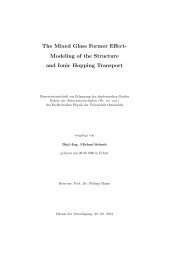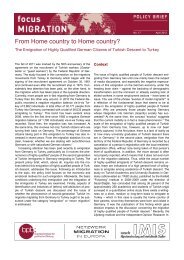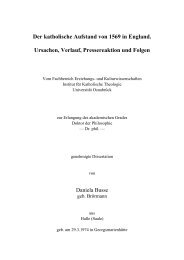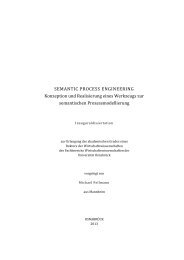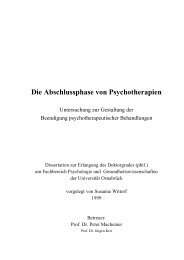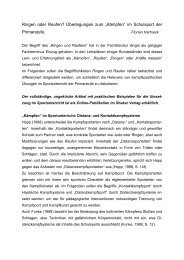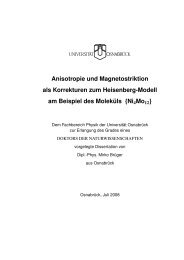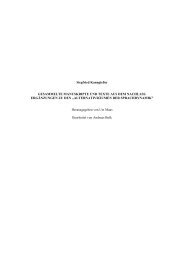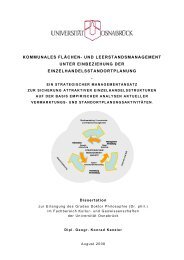346 Literatur HOLZINGER, A., KILIAN, R., LINDENBACH, I., PETSCHELEIT, A. & ANGERMEYER, M. C. (2003). Patients' and their relatives' causal explanations of schizophrenia. Social Psychiatry and Psychiatric Epidemiology, 38(3), 155-162. HOLZINGER, A., LÖFFLER, W., MÜLLER, P., PRIEBE, S., ANGERMEYER, M. (2002). Subjective illness theory and antipsychotic medication compliance by patients with schizophrenia. Journal of Nervous and Mental Disease, 190(9), 597- 603. HONIGFELD, G., GILLIS, R. D. & KLETT, C. J. (1966). NOSIE-30: A treatment-sensitive ward behavior scale. Psychological Reports, 19(1), 180-182. HORI, H., NOGUCHI, H., HASHIMOTO, R., NAKABAYASHI, T., OMORI, M., TAKAHASHI, S., TSUKUE, T., ANAMI, K., HIRABAYASHI, N., HARADA, S., SAITOH, O., IWASE, M., KAJIMOTO, O., TAKEDA, M., OKABE, S. & KUNUGI, H. (2006). Antipsychotic medication and cognitive function in schizophrenia. Schizophrenia Research, 86(1-3), 138-146. HORN, J. L. (1965). A rationale and test for the number of factors in factor analysis. Psychometrika, 30(2), 179-185. HOWES, O. D. & KAPUR, S. (2009). The dopamine hypothesis of schizophrenia: Version III—The final common pathway. Schizophrenia Bulletin, 35(3), 549-562. HULTMAN, C. M., WIESELGREN, I.-M., & ÖHMAN, A. (1997). Relationships between social support, social coping and life events in the relapse of schizophrenic patients. Scandinavian Journal of Psychology, 38(1), 3-13. HSU, L. M. (1989). Reliable changes in psychotherapy: Taking into account regression toward the mean. Behavioral Assessment, 11(4), 459-467. HSU, L. M. (1995). Regression toward the mean associated with measurement error and the identification of improvement and deterioration in psychotherapy. Journal of Consulting and Clinical Psychology, 63(1), 141-144. HSU, L. M. (1996). On the identification of clinically significant client changes: Reinterpretation of Jacobson's cut scores. Journal of Psychopathology and Behavioral Assessment, 18(4), 371-385. HSU, L. M. (1999). Caveats concerning comparisons of change rates obtained with five methods of identifying significant client changes: Comment on Speer and Greenbaum (1995). Journal of Consulting and Clinical Psychology, 67(4), 594-598. HUBER, G. (2005). Psychiatrie: Lehrbuch für Studium <strong>und</strong> Weiterbildung (7. Aufl.). Stuttgart: Schattauer. HWANG, S. S.-H., CHANG, J. S., LEE, K. Y., AHN, Y. M. & KIM, Y. S. (2009). The causal model of insight in schizophrenia based on the positive and negative syndrome scale factors and the structural equation modeling. Journal of Nervous and Mental Disease, 197(2), 79-84. IANCU, I., POREH, A., LEHMAN, B., SHAMIR, E. & KOTLER, M. (2005). The Positive and Negative Symptoms Questionnaire: A self-report scale in schizophrenia. Comprehensive Psychiatry, 46(1), 61-66. INGRAM, F., GREVE, K. W., FISHEL INGRAM, P. T. & SOUKUP, V. M. (1999). Temporal stability of the Wisconsin Card Sorting Test in an untreated patient sample. British Journal of Clinical Psychology, 38(2), 209-211. INHELDER, B. & PIAGET, J. (1958). The growth of logical thinking: From childhood to adolescence. New York: Basic Books. IVERSON, G. L., LOVELL, M. R. & COLLINS, M. W. (2003). Interpreting change on ImPACT following sports concussion. Clinical Neuropsychologist, 17(4), 460-467. IVNIK, R. J., MALEC, J. F., TANGALOS, E. G., PETERSEN, R. C., KOKMEN, E. & KURLAND, L. T. (1990). The Auditory-Verbal Learning Test (AVLT): Norms for ages 55 years and older. Psychological Assessment, 2(3), 304-312. JACOBSON, N. (2001). Experiencing recovery: A dimensional analysis of recovery narratives. Psychiatric Rehabilitation Journal, 24(3), 248-256. JACOBSON, N. S., FOLLETTE, W. C. & REVENSTORF, D. (1984). Psychotherapy outcome research: Methods for reporting variability and evaluating clinical significance. Behavior Therapy, 15(4), 336-352. JACOBSON, N. S., FOLLETTE, W. C. & REVENSTORF, D. (1986). Toward a standard definition of clinically significant change. Behavior Therapy, 17, 308-311. JACOBSON, N. S. & REVENSTORF, D. (1988). Statistics for assessing the clinical significance of psychotherapy techniques: Issues, problems, and new developments. Behavioral Assessment, 10(2), 133-145. JACOBSON, N. S., ROBERTS, L. J., BERNS, S. B. & MCGLINCHEY, J. B. (1999). Methods for defining and determining the clinical significance of treatment effects: Description, application, and alternatives. Journal of Consulting and Clinical Psychology, 67(3), 300-307. JACOBSON, N. S. & TRUAX, P. (1991). Clinical significance: A statistical approach to defining meaningful change in psychotherapy research. Journal of Consulting and Clinical Psychology, 59(1), 12-19. JÄGER, M., BOTTLENDER, R., STRAUSS, A. & MÖLLER, H. -J. (2004). Fifteen-year follow-up of ICD-10 schizoaffective disorders compared with schizophrenia and affective disorders. Acta Psychiatrica Scandinavica, 109(1), 30-37. JAHN, T. & MUSSGAY, L. (1989). Die statistische Kontrolle möglicher Medikamenteneinflüsse in experimentalpsychologischen Schizophreniestudien: Ein Vorschlag zur Berechnung von Chlorpromazinäquivalenten. Zeitschrift für Klinische Psychologie, 18(3), 257-267. JANKE, W., ERDMANN, G. & KALLUS, W. (1985). Der Stressverarbeitungsfragebogen (SVF). Göttingen: Hogrefe. JANSEN, L.M., GISPEN-DE-WIED, C.C. & KAHN, K.S. (1999). Coping with stress in schizophrenia. Schizophrenia Research, 36, 176. JANZ, N. K. & BECKER, M. H. (1984). The Health Belief Model: A decade later. Health Education Quarterly, 11(1), 1-47.
JANZARIK, W. (2003). Der Psychose-Begriff <strong>und</strong> die Qualität des Psychotischen. Nervenarzt, 74(1), 3-11. 347 Literatur JAZBEC, S., PANTELIS, C., ROBBINS, T., WEICKERT, T., WEINBERGER, D. R. & GOLDBERG, T. E. (2007). Intradimensional/extra-dimensional set-shifting performance in schizophrenia: Impact of distractors. Schizophrenia Research, 89(1-3), 339-349. JENSEN, J., WILLEIT, M., ZIPURSKY, R. B., SAVINA, I., SMITH, A. J., MENON, M., CRAWLEY, A. P. & KAPUR, S. (2008). The formation of abnormal associations in schizophrenia: Neural and behavioral evidence. Neuropsychopharmacology, 33(3), 473-479. JERUSALEM, M. & SCHWARZER, R. (1992). Self-efficacy as a resource factor in stress appraisal processes. In R. SCHWARZER (Hrsg.), Self-efficacy: Thought control of action (S. 195-213). Washington: Hemisphere Publishing. JETTEN, J., SPEARS, R. & MANSTEAD, A. S. R. (1996). Intergroup norms and intergroup discrimination: Distinctive selfcategorization and social identity effects. Journal of Personality and Social Psychology, 71(6), 1222-1233. JOHNS, L. C. & VAN OS, J. (2001). The continuity of psychotic experiences in the general population. Clinical Psychology Review, 21(8), 1125-1141. JOHNSON, E. A. (1995). Self-deceptive coping: Adaptive only in ambiguous contexts. Journal of Personality, 63(4), 759- 791. JOHNSON, S. & ORRELL, M. (1995). Insight and psychosis: A social perspective. Psychological Medicine, 25(3), 515-520. JOHNSON, S. & ORRELL, M. (1996). Insight, psychosis and ethnicity: A case-note study. Psychological Medicine, 26(5), 1081-1084. JOHNSON, S. C., BAXTER, L. C., WILDER, L. S., PIPE, J. G., HEISERMAN, J. E. & PRIGATANO, G. P. (2002). Neural correlates of self-reflection. Brain, 125(8), 1808-1814. JOHNSON-SELFRIDGE, M. & ZALEWSKI, C. (2001). Moderator variables of executive functioning in schizophrenia: Metaanalytic findings. Schizophrenia Bulletin, 27(2), 305-316. JOLLEY, S. & GARETY, P. A. (2004). Insight and delusions: A cognitive psychological approach. In X. F. Amador & A. S. David (Hrsg.), Insight and psychosis: Awareness of illness in schizophrenia and related disorders (2. Aufl.) (S. 89- 100). New York: Oxford University Press. JONES, E. G. & MENDELL, L. M. (1999). Assessing the decade of the brain. Science, 284 (5415), 739. JONIDES, J., LACEY, S. C. & NEE, D. E. (2005). Processes of working memory in mind and brain. Current Directions in Psychological Science, 14(1), 2-5. JOVANOVSKI, D., ZAKZANIS, K. K., YOUNG, D. A. & CAMPBELL, Z. (2007). Assessing the relationship between insight and everyday executive deficits in schizophrenia: A pilot study. Psychiatry Research, 151(1-2), 47-54. JUDD, C. M., MCCLELLAND, G. H. & CULHANE, S. E. (1995). Data analysis: Continuing issues in the everyday analysis of psychological data. Annual Review of Psychology, 46, 433-465. KAISER, S. L., SNYDER, J. A., CORCORAN, R. & DRAKE, R. J. (2006). The relationships among insight, social support, and depression in psychosis. Journal of Nervous and Mental Disease, 194(12), 905-908. KAPUR, S. (2003). Psychosis as a state of aberrant salience: A framework linking biology, phenolmenology, and pharmacology in schizophrenia. American Journal of Psychiatry, 160(1), 13-23. KARATZIAS, T., GUMLEY, A., POWER, K. & O'GRADY, M. (2007). Illness appraisals and self-esteem as correlates of anxiety and affective comorbid disorders in schizophrenia. Comprehensive Psychiatry, 48(4), 371-375. KAREKEN, D. A., MOBERG, P. J. & GUR, R. C. (1996). Proactive inhibition and semantic organization: Relationship with verbal memory in patients with schizophrenia. Journal of the International Neuropsychological Society, 2(6), 486- 493. KAROW, A., PAJONK, F.-G., REIMER, J., HIRDES, F., OSTERWALD, C., NABER, D. & MORITZ, S. (2008). The dilemma of insight into illness in schizophrenia: Self- and expert-rated insight and quality of life. European Archives of Psychiatry and Clinical Neuroscience, 258(3), 152-159. KATHMANN, N. (2001). Neurokognitive Gr<strong>und</strong>lagen schizophrener Symptome: Ein Überblick. Zeitschrift für Klinische Psychologie <strong>und</strong> Psychotherapie: Forschung <strong>und</strong> Praxis, 30(4), 241-250. KAUFFELDT, S. (1997). Generalisierbarkeit von Lernpotential im Bereich frontaler <strong>und</strong> temporaler Hirnfunktionen. Unveröffentlichte Diplomarbeit, Universität Osnabrück. KAY, S. R., FISZBEIN, A. & OPLER, L. A. (1987). The Positive and Negative Syndrome Scale (PANSS) for schizophrenia. Schizophrenia Bulletin, 13(2), 261-276. KAY, S. R. & SEVY, S. (1990). Pyramidical model of schizophrenia. Schizophrenia Bulletin, 16(3), 537-545. KEEFE, R. S. E. (2000). Working memory dysfunctions and its relevance to schizophrenia. In T. SHARMA & P. HARVEY (Hrsg.), Cognition in schizophrenia: Impairments, importance, and treatment strategies (S. 16-50). New York: Oxford University Press. KEEFE, R. S. E., BILDER, R. M., DAVIS, S. M., HARVEY, P. D., PALMER, B. W., GOLD, J. M., MELTZER, H. Y., GREEN, M. F., CAPUANO, G., STROUP, T. S., MCEVOY, J. P., SWARTZ, M. S., ROSENHECK, R. A., PERKINS, D. O., DAVIS, C. E., HSIAO, J. K. & LIEBERMAN, J. A. (2007). Neurocognitive effects of antipsychotic medications in patients with chronic schizophrenia in the CATIE trial. Archives of General Psychiatry, 64(6), 633-647. KEEFE, R. S. E. & FENTON, W. S. (2007). How should DSM-V criteria for schizophrenia include cognitive impairment? Schizophrenia Bulletin, 33(4), 912-920. KELLEY, T. L. (1947). F<strong>und</strong>amentals of statistics. Oxford: Harvard University Press.
- Seite 1 und 2:
Krankheitseinsicht, dynamisch getes
- Seite 3 und 4:
Danksagung iii Einleitung Es wird Z
- Seite 5 und 6:
v Einleitung 5.2.3.5 Prozessorienti
- Seite 7 und 8:
vii Einleitung 12.1.3 Ergebnisse St
- Seite 9 und 10:
ix Einleitung Tabelle 45. Hauptkomp
- Seite 11 und 12:
Tabelle 1. Verzeichnis der wichtigs
- Seite 13 und 14:
Abstract xiii Einleitung Objective:
- Seite 15 und 16:
15 Einleitung Angesichts der Belieb
- Seite 17 und 18:
17 Einleitung Bewältigungsmodell v
- Seite 19 und 20:
19 Wisconsin Card Sorting Test 2001
- Seite 21 und 22:
21 Wisconsin Card Sorting Test Effe
- Seite 23 und 24:
23 Wisconsin Card Sorting Test Das
- Seite 25 und 26:
Tabelle 2. Exekutive und Arbeitsged
- Seite 27 und 28:
3.3 Durchführung und Kennwerte des
- Seite 29 und 30:
3.4 WCST-Defizite bei Schizophrenie
- Seite 31 und 32:
Tabelle 5. Konzeptuelles Schema zur
- Seite 33 und 34:
3.5.1 Attributidentifikation / Abst
- Seite 35 und 36:
35 Wisconsin Card Sorting Test oder
- Seite 37 und 38:
37 Wisconsin Card Sorting Test elem
- Seite 39 und 40:
39 Wisconsin Card Sorting Test ein
- Seite 41 und 42:
41 Wisconsin Card Sorting Test Fehl
- Seite 43 und 44:
43 Wisconsin Card Sorting Test zus
- Seite 45 und 46:
45 Wisconsin Card Sorting Test Lern
- Seite 47 und 48:
3.5.5 Orientierungsvariablen 47 Wis
- Seite 49 und 50:
49 Wisconsin Card Sorting Test zehn
- Seite 51 und 52:
51 Wisconsin Card Sorting Test Fehl
- Seite 53 und 54:
53 Wisconsin Card Sorting Test mit
- Seite 55 und 56:
55 Wisconsin Card Sorting Test PAOL
- Seite 57 und 58:
Tabelle 6. Übersicht über Studien
- Seite 59 und 60:
3.7.3 Faktorstruktur des WCST 59 Wi
- Seite 61 und 62:
Tabelle 7 (Fortsetzung). (o) (p) (q
- Seite 63 und 64:
3.8.2 Bildung 63 Wisconsin Card Sor
- Seite 65 und 66:
3.9 Der Dynamische WCST in der Schi
- Seite 67 und 68:
67 Wisconsin Card Sorting Test darg
- Seite 69 und 70:
69 Wisconsin Card Sorting Test WIED
- Seite 71 und 72:
71 Wisconsin Card Sorting Test Durc
- Seite 73 und 74:
73 Wisconsin Card Sorting Test 3.9.
- Seite 75 und 76:
75 Wisconsin Card Sorting Test WALL
- Seite 77 und 78:
4. Statistische Modelle der Veränd
- Seite 79 und 80:
79 Reliable Change Index mittleren
- Seite 81 und 82:
81 Reliable Change Index (b) x2 sol
- Seite 83 und 84:
83 Reliable Change Index (3.) regre
- Seite 85 und 86:
85 Reliable Change Index Bei einem
- Seite 87 und 88:
87 Reliable Change Index statistisc
- Seite 89 und 90:
89 Reliable Change Index der Differ
- Seite 91 und 92:
91 Reliable Change Index Patienten
- Seite 93 und 94:
93 Reliable Change Index Tabelle 8.
- Seite 95 und 96:
95 Reliable Change Index WIEDL, WIE
- Seite 97 und 98:
97 Coping und Abwehr (3.) die oftma
- Seite 99 und 100:
Darstellung der wichtigsten tiefenp
- Seite 101 und 102:
101 Coping und Abwehr unterschiedli
- Seite 103 und 104:
103 Coping und Abwehr von Bewältig
- Seite 105 und 106:
105 Coping und Abwehr bedrohliche K
- Seite 107 und 108:
107 Coping und Abwehr das Problem d
- Seite 109 und 110:
5.2.3.6 Antezedenzien von Bewertung
- Seite 111 und 112:
6. Krankheitseinsicht von Menschen
- Seite 113 und 114:
113 Krankheitseinsicht die Bedeutun
- Seite 115 und 116:
115 Krankheitseinsicht Kombination
- Seite 117 und 118:
117 Krankheitseinsicht negative Bew
- Seite 119 und 120:
119 Krankheitseinsicht Während die
- Seite 121 und 122:
121 Krankheitseinsicht WARNER, TAYL
- Seite 123 und 124:
123 Krankheitseinsicht Symptomatik
- Seite 125 und 126:
125 Krankheitseinsicht (z. B. aus d
- Seite 127 und 128:
127 Krankheitseinsicht Diesem Zweck
- Seite 129 und 130:
6.5.2 Krankheitseinsicht: Begriffsk
- Seite 131 und 132:
131 Krankheitseinsicht Der erste be
- Seite 133 und 134:
Tabelle 11. Konfigurationen von Ein
- Seite 135 und 136:
6.5.4.1 Einsichts-Interviews 135 Kr
- Seite 137 und 138:
137 Krankheitseinsicht having sympt
- Seite 139 und 140:
139 Krankheitseinsicht Self-Apprais
- Seite 141 und 142:
141 Krankheitseinsicht chronifizier
- Seite 143 und 144:
143 Krankheitseinsicht have a menta
- Seite 145 und 146:
145 Krankheitseinsicht veröffentli
- Seite 147 und 148:
147 Krankheitseinsicht werden als r
- Seite 149 und 150:
149 Krankheitseinsicht Wichtig wär
- Seite 151 und 152:
151 Krankheitseinsicht Die Befundla
- Seite 153 und 154:
Pfad b Interaktionale Konstruktion
- Seite 155 und 156:
155 Krankheitseinsicht Validierung
- Seite 157 und 158:
6.5.12 Die nosologische Hypothese:
- Seite 159 und 160:
159 Krankheitseinsicht Die Möglich
- Seite 161 und 162:
161 Krankheitseinsicht Exekutivfunk
- Seite 163 und 164:
163 Krankheitseinsicht (z. B. HILL,
- Seite 165 und 166:
165 Krankheitseinsicht Einige Autor
- Seite 167 und 168:
167 Krankheitseinsicht Fehlattribut
- Seite 169 und 170:
6.5.14 Motivationale Hypothesen: Ab
- Seite 171 und 172:
171 Krankheitseinsicht Das RS-Konze
- Seite 173 und 174:
173 Krankheitseinsicht problemzentr
- Seite 175 und 176:
175 Krankheitseinsicht ursprünglic
- Seite 177 und 178:
177 Krankheitseinsicht reduzierter
- Seite 179 und 180:
179 Krankheitseinsicht äußerst kn
- Seite 181 und 182:
Prämorbide Intelligenz Psychose- E
- Seite 183 und 184:
183 Krankheitseinsicht personen, al
- Seite 185 und 186:
6.5.16 Multifaktorielle Einsichts-M
- Seite 187 und 188:
187 Krankheitseinsicht Erkrankungsb
- Seite 189 und 190:
7. Fragestellungen und Hypothesen 1
- Seite 191 und 192:
Hypothese 2.4: Validierung anhand d
- Seite 193 und 194:
Hypothese 3.3: Einsicht und Exekuti
- Seite 195 und 196:
8. Methoden 8.1 Beschreibung der In
- Seite 197 und 198:
197 Methoden Select-by-marker-Analy
- Seite 199 und 200:
199 Methoden eine weitere, eher all
- Seite 201 und 202:
201 Methoden Obwohl ursprünglich l
- Seite 203 und 204:
203 Methoden Tabelle 15 stellt den
- Seite 205 und 206:
205 Ergebnisse Studie 1 Hälfte auc
- Seite 207 und 208:
207 Ergebnisse Studie 1 Tabelle 18.
- Seite 209 und 210:
9.4 Hauptkomponentenanalyse des WCS
- Seite 211 und 212:
10. Ergebnisse Studie 2: 211 Ergebn
- Seite 213 und 214:
213 Ergebnisse Studie 2 postakuten
- Seite 215 und 216:
215 Ergebnisse Studie 2 entspricht
- Seite 217 und 218:
217 Ergebnisse Studie 2 Verteilung
- Seite 219 und 220:
Tabelle 24. Übersicht über berech
- Seite 221 und 222:
Tabelle 26. Zehn WCST-Performanztyp
- Seite 223 und 224:
223 Ergebnisse Studie 2 Zusammenhan
- Seite 225 und 226:
10.6 Unterschiedstests und Konkorda
- Seite 227 und 228:
227 Ergebnisse Studie 2 nach LANDIS
- Seite 229 und 230:
229 Ergebnisse Studie 2 zur Decke,
- Seite 231 und 232:
10.8 Komposition von Metatypen 231
- Seite 233 und 234:
Tabelle 35. Cluster-Varianzen und F
- Seite 235 und 236:
10.8.2 Übereinstimmung von RCI-Typ
- Seite 237 und 238:
Tabelle 39. Kreuztabelle WCSTdyn-Cl
- Seite 239 und 240:
239 Ergebnisse Studie 2 Die dargest
- Seite 241 und 242:
Tabelle 42. Korrekte Sortierungen i
- Seite 243 und 244:
10.9 Soziodemographische und klinis
- Seite 245 und 246:
Tabelle 45. Rotierte Komponentenmat
- Seite 247 und 248:
10.10 Externe Validierung der Metat
- Seite 249 und 250:
249 Ergebnisse Studie 2 Es besteht
- Seite 251 und 252:
Tabelle 51. Lernverläufe der AVLT-
- Seite 253 und 254:
253 Ergebnisse Studie 2 10.10.3 Faz
- Seite 255 und 256:
255 Ergebnisse Studie 2 Angesichts
- Seite 257 und 258:
10.12 Analyse von WCST-Fehlerprofil
- Seite 259 und 260:
259 Ergebnisse Studie 2 ausschließ
- Seite 261 und 262:
261 Ergebnisse Studie 2 Die Fehler-
- Seite 263 und 264:
263 Ergebnisse Studie 3 den Zusamme
- Seite 265 und 266:
265 Ergebnisse Studie 3 übrigen It
- Seite 267 und 268:
267 Ergebnisse Studie 3 Partialkorr
- Seite 269 und 270:
Tabelle 66. Symptombewusstheit, Pos
- Seite 271 und 272:
271 Ergebnisse Studie 3 11.6 Konver
- Seite 273 und 274:
11.8 Aktive und passive Medikations
- Seite 275 und 276:
11.10 Einsicht, Exekutivfunktionen
- Seite 277 und 278:
277 Ergebnisse Studie 3 Offenheit k
- Seite 279 und 280:
279 Ergebnisse Studie 3 52 Patiente
- Seite 281 und 282:
281 Ergebnisse Studie 3 wies einen
- Seite 283 und 284:
283 Ergebnisse Studie 3 Insgesamt k
- Seite 285 und 286:
285 Ergebnisse Studie 3 Das gleiche
- Seite 287 und 288:
287 Ergebnisse Studie 3 G12 = 3,5 (
- Seite 289 und 290:
Tabelle 81. Kognition und Symptomat
- Seite 291 und 292:
291 Ergebnisse Studie 3 Aufgrund de
- Seite 293 und 294:
293 Ergebnisse Studie 3 Es ist auff
- Seite 295 und 296: 295 Ergebnisse Studie 3 Im nächste
- Seite 297 und 298: 297 Ergebnisse Studie 3 kognitiv le
- Seite 299 und 300: 299 Diskussion An einer nicht-psych
- Seite 301 und 302: Hypothese Gegenstand Ergebnis 2.1 S
- Seite 303 und 304: 3.5 Kurvilinearer Zusammenhang (qua
- Seite 305 und 306: 12.2.2 Diskussion Studie 2: RCI-Ver
- Seite 307 und 308: 307 Diskussion Insbesondere scheint
- Seite 309 und 310: 309 Diskussion »Metatypen« zu kl
- Seite 311 und 312: 311 Diskussion Fehlertypen: Währen
- Seite 313 und 314: 313 Diskussion Funktionsbereiche (s
- Seite 315 und 316: 12.2.3.1 Diskussion der OSSTI 315 D
- Seite 317 und 318: 12.2.3.2 Einsicht und Depressivitä
- Seite 319 und 320: 12.2.3.3 Einsicht und Exekutivfunkt
- Seite 321 und 322: 321 Diskussion Arbeitsgedächtnis (
- Seite 323 und 324: 323 Diskussion zur hirnorganisch ve
- Seite 325 und 326: 12.2.3.5 Überprüfung des Einsicht
- Seite 327 und 328: 327 Diskussion sozialer Konsequenze
- Seite 329 und 330: 329 Diskussion Diagnose zurückwies
- Seite 331 und 332: 12.3 Schlusswort 331 Diskussion Die
- Seite 333 und 334: Literatur ACKERMANN, R. & DERUBEIS,
- Seite 335 und 336: 335 Literatur BAUMEISTER, R. F., DA
- Seite 337 und 338: 337 Literatur BURNS, J. W. (2000).
- Seite 339 und 340: 339 Literatur DABAN, C., AMADO, I.,
- Seite 341 und 342: 341 Literatur FERRERI, M., ROUILLON
- Seite 343 und 344: 343 Literatur GOLDMAN, R. S., AXELR
- Seite 345: 345 Literatur HAYGOOD, R. C. & BOUR
- Seite 349 und 350: 349 Literatur KOLB, B. & WHISHAW, I
- Seite 351 und 352: 351 Literatur LYSAKER, P. H. & BELL
- Seite 353 und 354: 353 Literatur MCGUIGAN, F. J. (1974
- Seite 355 und 356: 355 Literatur NIEUWENSTEIN, M. R.,
- Seite 357 und 358: 357 Literatur PINI, S., CASSANO, G.
- Seite 359 und 360: 359 Literatur SACKEIM, H. A. & GUR,
- Seite 361 und 362: 361 Literatur SMITH, T. E., HULL, J
- Seite 363 und 364: 363 Literatur TRANULIS, C., LEPAGE,
- Seite 365 und 366: 365 Literatur WEILER, M. A., FLEISH
- Seite 367 und 368: 367 Literatur YOUNG, D. A., ZAKZANI
- Seite 369 und 370: Perseverative Fehler Prätest .161
- Seite 371 und 372: C Einverständniserklärung 371 Anh
- Seite 373 und 374: E Fragebogen zur Behandlungseinsch
- Seite 375 und 376: F FKV-Instruktion »Trait« 375 Anh
- Seite 377 und 378: Coping Strategies Task (CST): Auswe
- Seite 379: 379 Anhang Erklärung über die Eig



